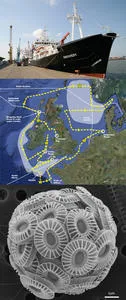
We are steaming rapidly northwards parallel to the west coast of Norway. Soon we will reach our most northerly latitude, 60°N, and turn westwards for home.
In today’s blog Sophie Richier describes some additional science that she is carrying out, over and above managing the bioassay experiments.

During our cruise we have gathered convincing evidence that the seas around the British Isles experience fairly similar summer weather to that on land; today is yet another grey day, with clouds stretching unbroken from one horizon to the other.
As well as my cleaning duties I have also been doing some sampling for molecular biology analyses, or, in other words, genes and products of genes from the marine microbial community present in the waters along our trip. I have to admit that it is not as exciting as all the analyses performed by everybody else on this cruise, mainly because you do not have the results straight away and you have to wait to be back on land! On this particular mission, I have to work blind and rely on the indications provided by the others to make sure I have enough biological material to work on back in the lab.
Molecular biology is also not so appealing to some people as it seems really complex... ”Is that something about DNA, genes... bolo... meta... metabolomics... you are interested in?” I have been asked.
Well, because we are exploring the impact of ocean acidification on marine ecosystems, a key link is understanding the impact on individual organisms. In our case this means individual microbes. A potentially productive path for ocean acidification research is to make use of ‘omics’ tools such as transcriptomic and proteomic tools to understand the mechanisms that might be driving changes in organism size, shape (of skeletons or shells for calcifying organisms) and physiology. In addition, they could help to reveal whether potential compensation in the key pathways for biological processes is possible.
On this cruise, I am planning on monitoring the molecular response (gene and protein expression) of the microbial community exposed to either experimental high pCO2 (in the bioassays) or in situ pCO2 (CTD samples).
One issue was to stay clean, or as clean as possible, on a dirty ship. You really want to avoid the genes and proteins from us humans becoming mixed up with the genes and proteins of the microbial creatures you are exploring! Sometimes when we were running out of water on the CTD and my clean bottles were half full, people were really generous and wanted to share but unfortunately I had to show my best smile and answer as politely as possible “not interested, your water is just too dirty!”.
Monitoring gene expression in a microbial population consists in looking at which genes are being more actively used (upregulated) or conversely inhibited in response to ocean acidification. This particular approach gives us information about the capacity of microbes to adapt to climate change, also known as ‘plasticity’.
Because proteins have their origin in genes, as a parallel and complementary approach, I am also interested in which proteins are being produced in greater or lesser amounts in microbes subjected to a changing environment.
The first thing happening, at a molecular level, in microbes subjected to environmental changes is the regulation of the genes (some get “switched on” and others “switched off”). Even though genes and proteins are tightly linked, switching on of a gene does not always mean that its related proteins will get produced. Thus studying both microbial genes and proteins is essential and constitutes a complementary approach to other oceanographic measurements. Introducing molecular approaches to our observation will surely help us understand not only what changes may occur, but also why they will occur.